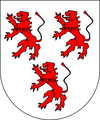Cambrai Monastery
|
Territory in the Holy Roman Empire |
|
|---|---|
| Cambrai Monastery | |
| coat of arms | |

|
|
| map | |

|
|
| Cambrai bishopric around 1250 (violet, "diocese Kamerich", left of Hainaut) | |
| Alternative names | Kammerich |
| Form of rule | Electoral principality / corporate state |
| Ruler / government | Prince-bishop , administrator or vacant : cathedral chapter |
| Today's region / s | FR-59 |
| Reich register | Contingent 22 men on horseback and 82 men on foot (1521) |
| Reichskreis | Lower Rhine-Westphalian |
| Capitals / residences | Cambrai |
| Denomination / Religions | Roman Catholic , Jewish minority |
| Language / n |
Latin , French, Dutch
|
| Incorporated into | Secularized in 1802
|
The bishopric of Cambrai (Kammerich), archbishopric from 1559 , was the secular domain of the bishops and archbishops of Cambrai from 1007 to 1802.
history
Around 500 or at the end of the 6th century the diocese of Cambrai emerged as a suffragan diocese of the archdiocese of Reims . When the Franconian Empire was divided after Charlemagne's death , the area of the Cambrai diocese became part of Lorraine and later became part of the Holy Roman Empire .
In the year 1007 the bishops of Heinrich II. The county Cambrai was given as an imperial fief. This was the beginning of the Cambrai Monastery. At times the Counts of Flanders exercised the patronage of the bishopric. The city of Cambrai has resisted episcopal rule since 1077 and became a free imperial city in the High Middle Ages .
The first attempts to annex the bishopric to France were made in 1298 under King Philip IV. At the height of Burgundian power in the late Middle Ages, the bishops were mostly relatives of the Burgundian dukes. From 1439, Burgundy claimed patronage over the bishopric. Maximilian I . elevated the county of Cambrai to a duchy in 1510. Since then the secular title of the bishop has been (even in French times): duc de Cambrai, prince du S. Empire, comte de Cambrai .
In the imperial register of 1521 the bishop is entered with a contingent of 22 men on horseback and 82 men on foot. The country was divided into 12 pairs.
In 1559 the diocese of Cambrai was raised to an archbishopric. The bishopric, now ore monastery, belonged to the Lower Rhine-Westphalian Empire . But by 1541 Cambrai was no longer a permanent member of the imperial circle. The relationship with the Burgundian Empire remained unclear .
France tried again and again in vain to win the area for itself. It only fell to France in the Peace of Nijmegen in 1678/79.
See also
literature
- General Encyclopedia of Sciences and Arts. Vol. 15. Leipzig, 1826 p. 6ff. Digitized
- Gerhard Köbler : Historical lexicon of the German countries. The German territories from the Middle Ages to the present. 4th, completely revised edition. CH Beck, Munich 1992, ISBN 3-406-35865-9 , p. 102.
